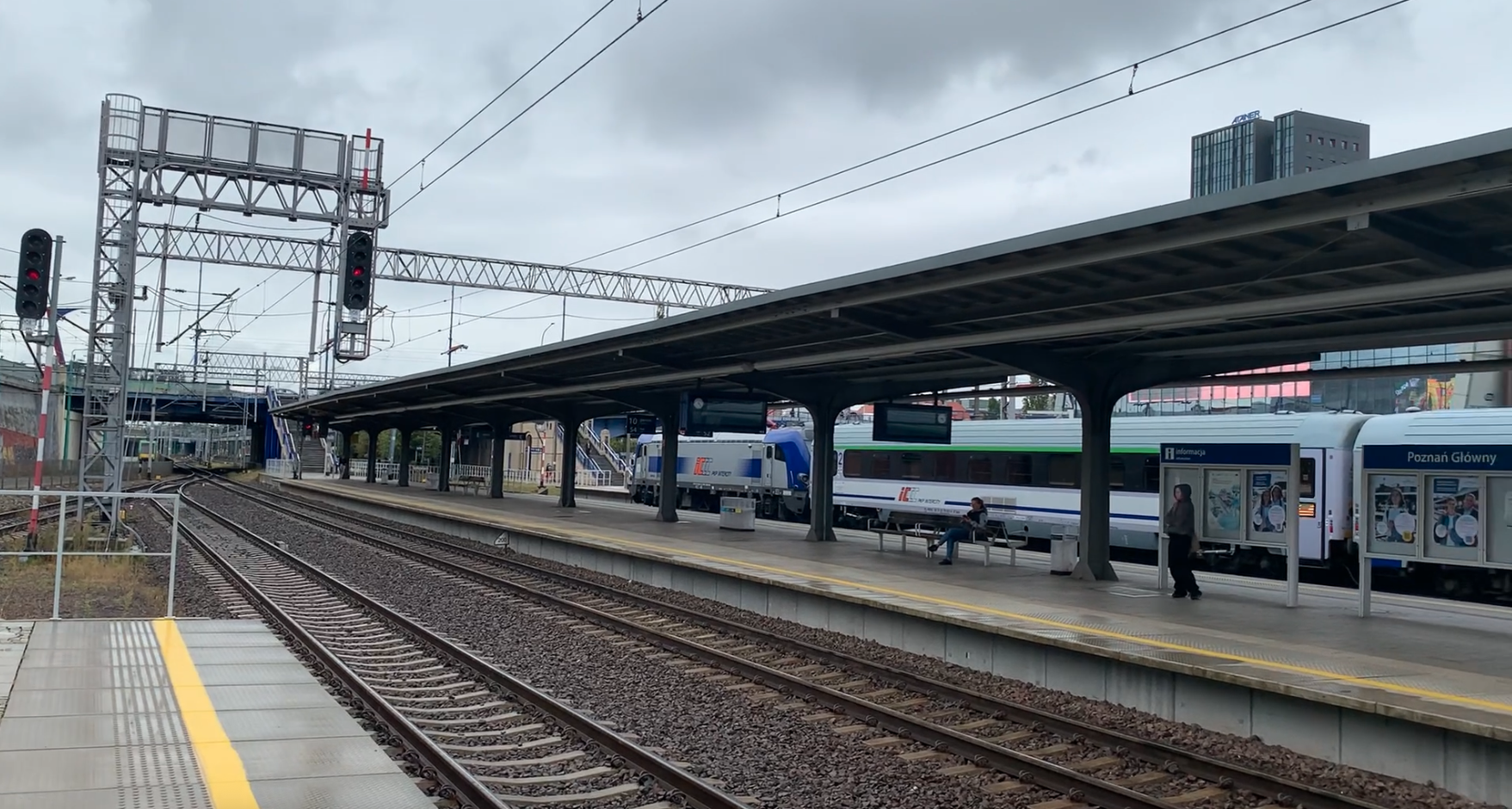Poznań 2025-05-23
Railway line No. 351 Poznań Główny – Szczecin Główny.
The line connects two large cities in Poland. The line is 213,500 km long, double-track, electrified with 3 kV DC. The track gauge is normal, i.e. 1435 mm. Geographically, the line runs diagonally, in a north-westerly direction and is located in north-west Poland, in the Wielkopolska, Lubuskie and West Pomeranian Voivodeships. The line is the main route connecting Szczecin with the center of Poland, although not the only one. The current manager of the line is PKP PLK, which originates from PKP. LK 351 lies in the area of PKP PLK Zakładów Liii Kolejowych in Poznań, Zielona Góra and Szczecin. The maximum speed on the line is 160 km/h. The line was included in the international main line No. E 59, which connects Scandinavia with Southern Europe.
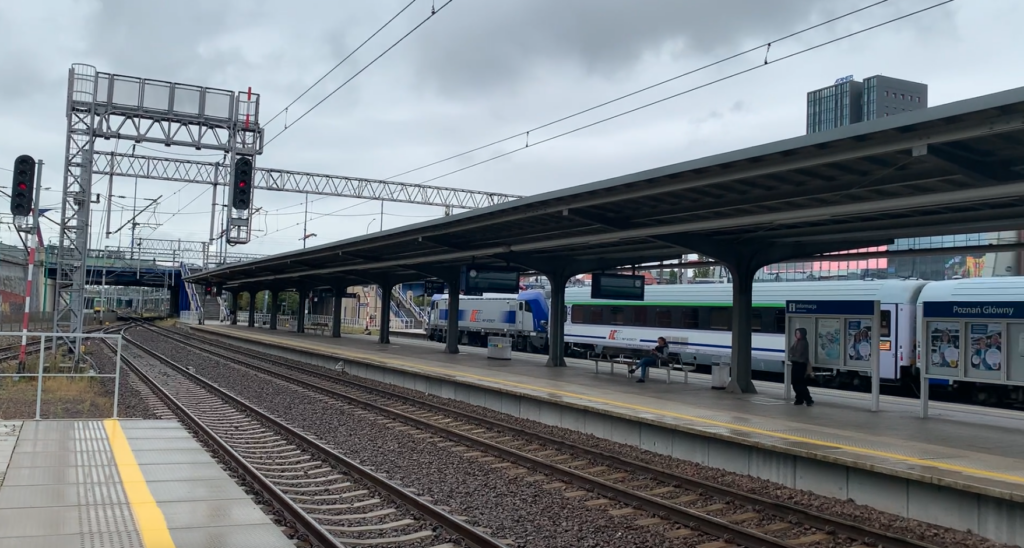
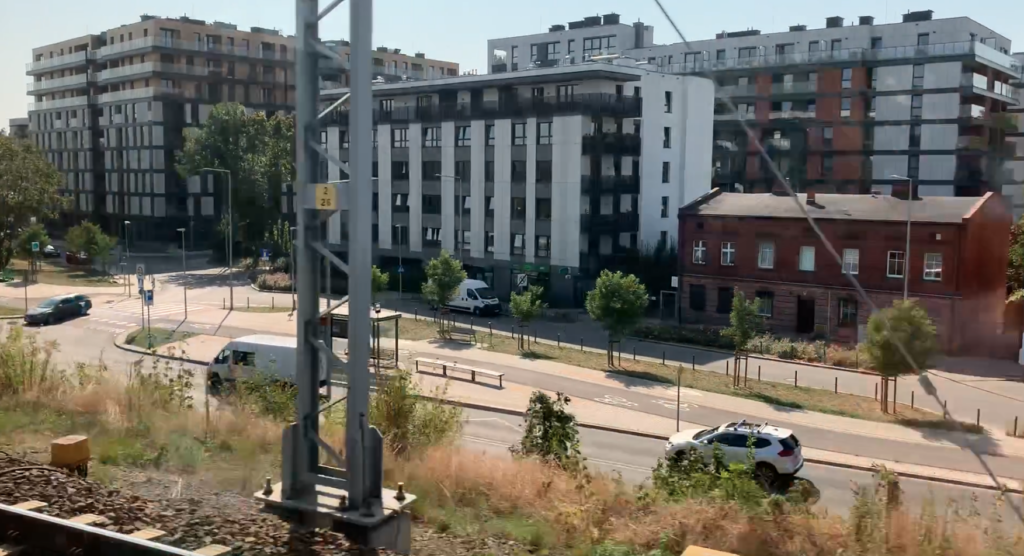
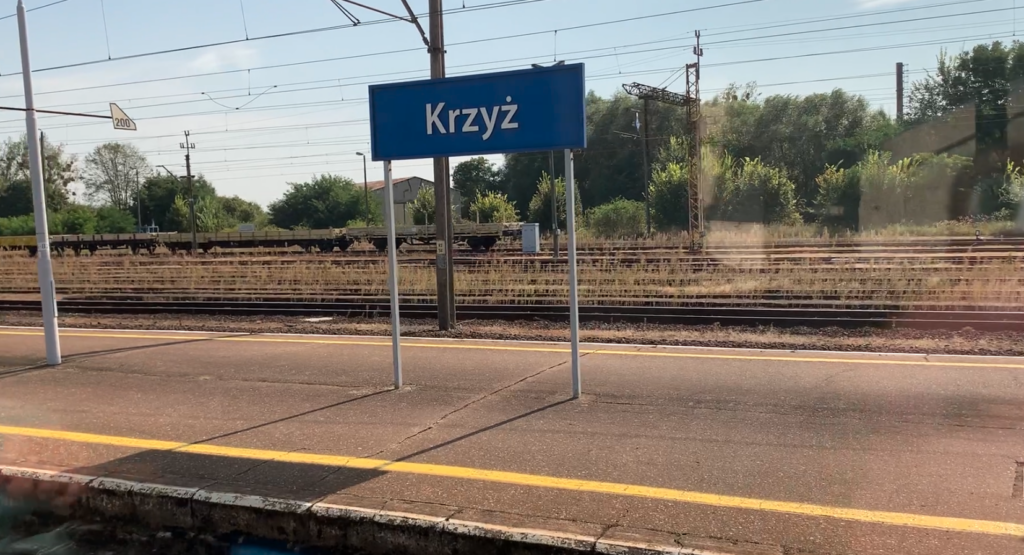

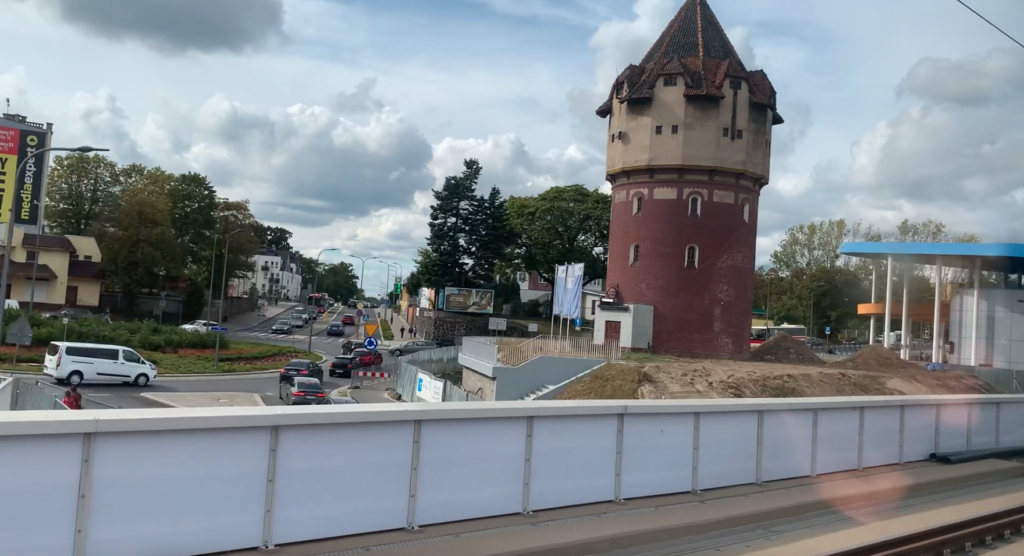
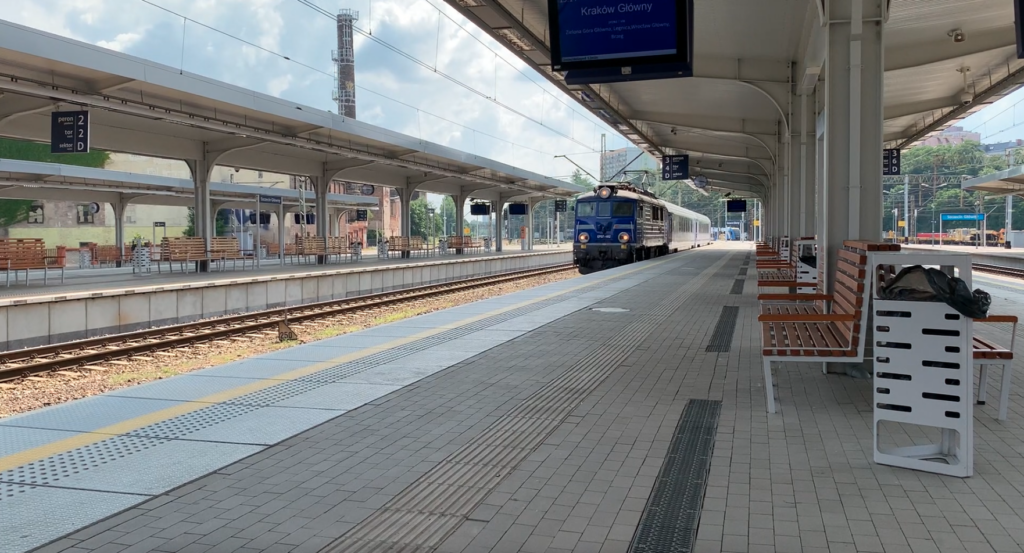
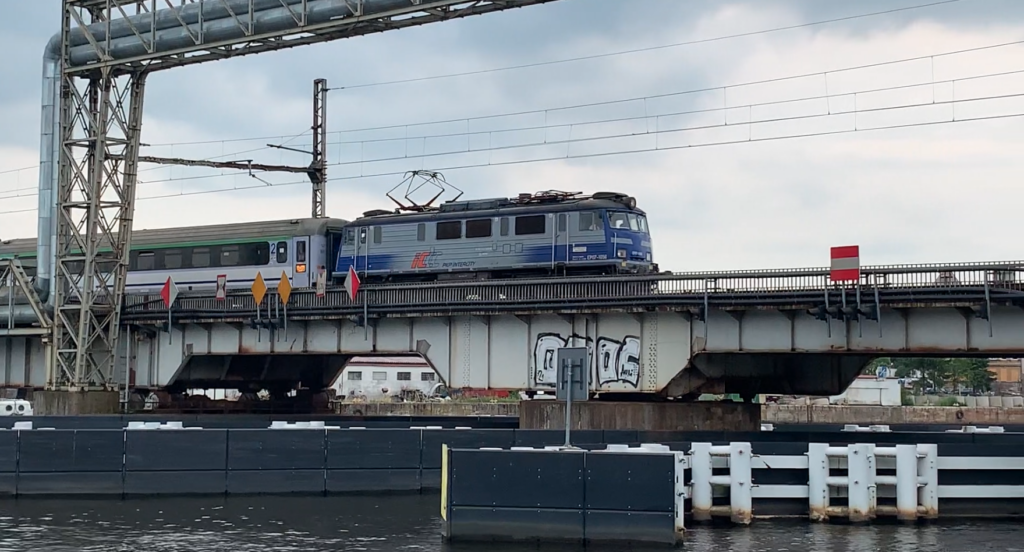
Route of LK No. 351 Poznań – Szczecin.
Poznań station (0.00 km, elevation 72 m) is a large railway junction from which you can go in eight directions; Szamotuły, Oborniki, Murowana Goślina, Gniezno, Kostrzyn, Środa Wielkopolska, Kościan, Opalenica. LK No. 351 leaves Poznań Główny station in the north direction, and in the city center, in a tight arc, with an angle of 90 degrees, turns west. In the Niestachów housing estate, the line splits and tracks branch off north towards Oborniki. Then the line gradually takes a constant north-west direction.
Poznań Wola station (6.53 km, elevation 88 m), currently a passenger stop and a loading bay.
Kiekrz station (12.90 km, elevation 78 m). Here, LK No. 351 is joined from the east by the Poznań Commuter Bypass (LK No. 395). Further above the line runs the S11 motorway.
Rokietnica station (17.74 km, elevation 93 mm). There is LK No. 363 here.
A commemorative passenger stop (24.25 km, elevation 83 m).
Baborówko passenger stop (29.42 km, elevation 71 m).
Szamotuły station (33.04 km, elevation 69 m). There is LK No. 368 here. The line crosses DW No. 184 and No. 187 and DW No. 184 again. At 37.59 km, there was a no longer operational Gaj loading station.
Pęckowo passenger stop (42.38 km, elevation 73 m). The line then runs under DW No. 182. At 46.96 km there was a Samołędź sectional post.
Wronki station (51.10 km, elevation 53 m). There is LK No. 381 here. There is a plant for impregnating wooden railway sleepers at the station. The line crosses DW No. 182 twice. The line crosses the Warta River on a bridge. At 55.35 km there was a Krzywołęka sectional post.
Wronki Zamość passenger stop. The stop was built in December 2024. Further on, the line crosses DW No. 150 at an intersection. Then the line enters the Noteć Forest.
Mokrz passenger stop (59.46 km, elevation 61 m). At 64.34 km there was a Głuchowiec section post.
Miały station (70.11 km, elevation 54 m). Before the station, the line crosses the Miała River. At 73.39 km, there was a Osina section post.
Drawski Młyn station (78.00 km, elevation 44 m). There is LK No. 206 here. Here the line leaves the Noteć Forest. At the station, the line crosses DW No. 181 at an intersection. Further on, the line crosses the Noteć River. In 1919, after Wielkopolska joined the reborn Republic of Poland, the railway line was divided by the state border, for 79.70 km. Krzyż station was on the German side. On the Polish side, the last station was Drawski Młyn station. The border crossing was used sporadically. The Drawski Młyn – Bzowo Goraj railway line was modernized.
Krzyż station (83.72 km, elevation 33 m). LK No. 203, 351b, 412. Here the line crosses the former Ostbahn Berlin – Królewiec line without any collisions, an example of love between Prussian and Muscovite brothers. Currently, the station serves, among others, for transfers towards Gorzów Wielkopolski, and sometimes towards Piła. In 1912, in the area of Krzyż station, the route of line No. 351 was changed on the Krzyż – Drawiny section and a viaduct was built over LK No. 203. Thanks to this, both lines became grade-separated. Further on, the line crosses DW No. 174 on a viaduct. Then it crosses the Drawa River, simultaneously entering the Lubuskie Voivodeship (87.82 km). The old route of the line was changed to Długa Street in Krzyż.
Drawiny passenger stop (92.12 km, elevation 39 m). The line enters the forests again.
Podlesie station (97.14 km, elevation 49 m).
Mierzęcin passenger stop (100.42 km, elevation 56 m). There is an intersection with DW No. 161 here. Further on, the line crosses the Mierzęcka Struga River, and does so three times.
Dobiegniew station (106.65 km, elevation 69 m). Here the line crosses DK No. 22 and DW No. 160. It is 109.67 km long, the line crosses the border of the Lubuskie and Zachodniopomorskie provinces. At 110.89 km, there was a section post Jaglisko.
Bierzwnik station (115.36 km, elevation 77 m).
Rębusz passenger stop (120.82 km, elevation 78). Further on the line leaves the forests and begins arable fields.
Słonice station (127.31 km, elevation 85 m).
Stary Klukom passenger stop (133.63 km, elevation 69 m).
Choszczno station (138.73 km, elevation 60 m). There is LK No. 410 here. The station used to be a large junction station. Behind the station, the line passes under the viaduct of DW No. 151. Behind the town of Choszczno, the line changes direction several times, bypassing the tongue and glacial elevations.
Ziemomysł passenger stop (145.69 km, elevation 51 m).
Dolice station (152.87 km, elevation 43 m). Here the line crosses the intersection of DW No. 122.
Morzyca passenger stop (157.26 km,, elevation 36 m).
Kolin passenger stop (160.94 km, elevation 38 m). It used to be a station.
Strzebielewo passenger stop (162.99 km, elevation 33 m). At 163.06 km, there was a passenger stop Strzebielewo Pyrzyckie.
Witkowo passenger stop and branch post (166.60 km, elevation 25 m). There is LK No. 351c here. Further on the line crosses the Mała Ina river. Then the line runs under the S10 motorway.
Stargard large junction station (173.30 km, elevation 34 m). LK No. 202, 351d, 411. In Stargard the line meets the railway line from the Tri-City. From Stargard the line heads westwards, to Szczecin.
Grzędzice passenger stop (178.00 km, elevation 30 m).
Miedwiecko passenger stop (181.31 km, elevation 20 m). The line enters the forests again; Goleniowska Forest.
Reptowo station (185.71 km, elevation 21 m). At 188.68 km, there was an access post Wrzosy.
Szczecin Zdunowo passenger stop (192.05 km, elevation 16 m). Further on the line crosses the river; Chelszczaca Channel. On the northern side of the line is Dunikowo Business Park; this is the only industrial park in Szczecin with a versatile purpose, with direct access to a railway siding and a railway junction. The line crosses the A6 and S3 motorways at the bottom. The line crosses the river; Płonia Channel. Then there is the Szczecin Dąbie railway junction. Urbanized areas begin.
Szczecin Dąbie station (195.93 km, elevation 9 m). LK No. 857, 273, 401, 417, 428. The line becomes multi-track (three, four tracks). Here the railway line branches off towards the city of Goleniów and further to Świnoujście. After the station, the line crosses DK No. 10, Andrzeja Struga Street. At 200.60 km, there was a section post Kijewo.
Szczecin Zdroje passenger stop (201.93 km, elevation 15 m). LK No. 428, 853. On the southern side, the line borders the Szczecin Landscape Park “Puszcza Bukowa”. Then the line crosses the Regalica River. Then the line crosses other railway lines. The line runs along DK No. 31 and the river; Kanał Leśny. Then the line crosses the Odra Zachodnia River. The line turns north. The area is very urbanized. Many railway lines cross here and there are branch posts: Reglica (204.07 km, LK No. 855), Dziewoklicz (207.93, km, LK No. 854), Szczecin Wstowo (209.62 km, LK No. 432, 851, 998).
Railway line No. 351 enters the Szczecin Główny station, whose platforms are set in a north-eastern direction. The station is located between the Western Oder River and the Nowe Miasto district, which is on a slope. The station was opened in 1843, when the first train from Berlin arrived here. An interesting fact is the old layout of the Szczecin Główny station, which was initially a headland station. Trains leaving towards Stargard were pushed out of the platforms in an arc towards the west (partly into an impassable tunnel), and then (after changing the headland) towards the west and a wooden bridge across the Western Oder, towards Stargard. The change took place in 1869, when the station in Szczecin became a through station. Bridges were built over the Western Oder and Parnica rivers.
The line crosses large rivers: Warta, Noteć, Drawa, Regalica and Western Oder, as well as several smaller rivers and canals. The line runs through three large forests: Notecka Forest, Drawska Forest and Goleniowska Forest.
History of LK No. 351.
In its history, the line was created as Ostbahn, with great support from the Prussian royal treasury. The first train arrived in Szczecin in 1843, from Berlin. In 1846, the Szczecin – Stargard line was opened. At that time, the Starogrodzko – Poznań Railway Company was established. The company developed a plan to build a Stargard – Poznań railway line. On March 4, 1846, King Frederick William IV Hohenzollern approved the plan to build this route and issued a concession. King Frederick William IV participated in all important events related to the railway in Prussia. The construction of the line began on March 20, 1846, from the Stargard side, and then also from Krzyż Wielkopolski and from Poznań. The first train on the Stargard – Poznań route arrived in Poznań on August 10, 1848.
The concept of building the Ostbahn network was created in 1842. However, various concepts clashed over the route of the route and, above all, its financing. The Ostbahn was to open up the Prussian territories east of Berlin with the cities of Gdańsk, Königsberg (Królewiec), Bromberg (Bydgoszcz), Thorn (Toruń) and the cities of Eydtkuhnen and Alexandrowo (Aleksandrów Kujawski) on the border with Russia. The classic Ostbahn route was to run from the old Berlin Ostbahnhof on Küstriner Platz through Küstrin (Kostrzyń), Kreuz (Krzyż), Schneidemühl, Dirschau and Königsberg (Prussia) to Eydtkuhnen on the Prussian-Russian border.
The main idea was to connect Berlin with Moscow and St. Petersburg. Officially, the Ostbahn was built to connect Berlin with Königsberg (now Kaliningrad) and further east. The Prussian part of the railway was to end in Eytkunami (now Chernyshevskoye). Geographic coordinates 54 degrees 38 minutes N 22 degrees 44 minutes E. The Russian Empire Railway was to be built next. The Prussian, main part of the railway route was to be from 790 km to 810 km, depending on the chosen variant of the line.
The Ostbahn was not the first Prussian railway undertaking. Construction of the important Berlin–Szczecin railway line, which was extended to Stargard Szczeciński (now Stargard), had begun early on. The 180 km long Stargard Szczeciński–Poznań route had already been planned and implemented. The Berlin–Kostrzyn nad Odrą line had also been built. Railway lines had already been run from Kostrzyn towards Wrocław and Vienna.
Work on the Ostbahn began in 1846, when construction of a large station and railway line towards Piła, which was 64 km away, began in the town of Krzyż, at the 93 km point of the Stargard Szczeciński–Poznań route. However, work was soon interrupted and resumed in 1848.
Since no private investors were found to build a railway to the relatively sparsely populated areas of East Prussia, the Ostbahn was built as a state railway. The draft of the relevant decree was submitted to the Prussian parliament in mid-1847. The proceedings lasted over two years. After administrative changes, the decree was adopted as a law on 7 December 1849.
The revolutionary unrest in Berlin in 1848, as well as the prevailing unemployment and increasing impoverishment of the population, played an important role in the construction of the Ostbahn. In the spring of 1848, the state offices came up with the idea of removing the rebellious and unemployed Berliners from the city and using them to build the Ostbahn.
In June 1848, new construction workers arrived at Dragebruch near Kreuz (Cross). By September 1848, the number of employees had already increased to 1,300 people. They worked 12-14 hours a day. The workers were quartered in barracks and with local farmers. Engineers delegated from Berlin supervised the workers. The work progressed relatively quickly.
Most Ostbahn tracks were planned as double-track. Only a few were single-track. European tracks with a gauge of 1435 mm were used. The distance of the track axes between one track and the other was 4.00 m. The sleepers were made of pine wood from a length of 2.50 m. The total track width was 10.40 – 11.00 m. The single-track track had a minimum width of 4.50 m. The sleepers were laid on a gravel bed, and in places where the gravel was washed out, on a crushed stone bed. Drainage ditches were made along the track on both sides. This was the case when the line was laid in flat terrain. It was more difficult to build a railway line in undulating terrain, where embankments or cuttings had to be made. At that time, much larger masses of earth and rock material had to be transported. Initially, the rails were made of iron, and later they were replaced with steel rails. This is where the name Railway comes from. The biggest problems were caused by the construction of bridges over rivers. Bridgeheads were always built with a double-track line in mind, although initially a bridge span was laid for a single track. In general, in Pomerania, the construction of railway lines was relatively easy and allowed for the construction of very long straight sections. Few structures were built on embankments and cuttings. Telegraph and telephone lines were built along the tracks.
In the 19th century, the organization of work in Prussia was strongly associated with the economic and social changes resulting from the industrial revolution, agrarian reforms and the development of the Prussian state as a strong bureaucratic monarchy. At the beginning of the 19th century (1807–1816), the Stein-Hardenberg reforms were introduced, which abolished serfdom and allowed peasants to acquire land for themselves. However, the peasants did not have the financial resources, so banks came to the rescue, granting loans at high interest (usury). As a result, a significant number of landless rural workers were created, who were called farmhands. Only a small class of independent peasants, farmers, emerged. Many peasants and rural workers took seasonal work on landed estates, often on a contract basis. From the mid-19th century, especially after 1850, the development of industry intensified; mainly mining, metallurgy and the textile industry. Large industrial plants were established, in which work was organized in a hierarchical manner, with division into management and workers. Industrial plants had strict work regulations, there were penalties for lateness, and the workday lasted 12-14 hours. The rural poor moved to cities in search of work, which encouraged the emergence of a proletariat class. As a result, an excellent ground was created for the development of communism. Let us also remember that in Prussia there was no attachment to religion, because since the Reformation, confusion had been created in the minds of the lower social classes. Workers often worked in difficult conditions, without social security. In factories, women and children worked equally with men. In the first half of the 19th century, workers were deprived of the right to organize, strike or negotiate working conditions. Prussian authorities feared the radicalization of the working class, so they used various forms of supervision and repression.
The Prussian monarchy was an absolute and bureaucratic monarchy. Work in the administration was strongly hierarchical, based on loyalty to the state and official discipline. Compulsory schooling was introduced and vocational schools were developed, which was to prepare young people for work in industry or administration. It was not until the end of the 19th century that the social situation of workers began to improve. Social insurance was introduced: sickness insurance (1883), accident insurance (1884), retirement insurance (1889). This was to counteract the radicalization of the labor movement and strengthen the loyalty of workers to the state, or rather the administration. Let us remember that social insurance was only applicable to workers working on the basis of a written contract, which was concluded only after a minimum of 5 years of work.
The work of Prussian workers on construction sites in the 19th century was hard, poorly paid and without social protection, but also crucial for the development of urbanization and infrastructure in Prussia. Construction work was usually seasonal, performed from spring to autumn. In winter, there was often no employment. The work included the construction of houses, factories, bridges, roads, railways and water canals. The development of railways was particularly intensive, dating from the 1840s. Most of the work was done by hand, with the help of shovels, pickaxes and hammers. Wheelbarrows were mainly used for transport. Construction machines such as cranes, concrete mixers, and saws were rare. Workers were organized into work groups (brigades) supervised by a master (foreman). Many workers had no vocational education and this was a workforce from the poorest social classes, often from rural areas or from the Moscow and Austrian partitions. Contracts were oral or short-term, and payments often depended on the completion of the task. Construction workers’ earnings were low and employment was uncertain. There was no assistance in the event of illness or accident. Work lasted 12-14 hours a day, from dawn to dusk, with only one day off, Sunday. Workers often lived in barracks, without toilets or clean water. Diseases often developed, often contagious. In this way, workers brought the cholera epidemic to Poznań. There were no health and safety regulations, no gloves, no helmets, the scaffolding was temporary, and accidents were very common. The injured and sick often lost the opportunity to continue working and did not receive any benefits. Construction workers were a low social class, deprived of respect and even the opportunity to practice their faith. Workers were considered unskilled. It was not until the end of the 19th century that trade unions and craft associations began to be formed, which fought for the improvement of working conditions.
Testimony of a Prussian worker from 1880 – “We get up before dawn and eat bread and drink black coffee. We walk to the construction site, over two kilometers. Work begins as soon as we can see something. Stone by stone, brick by brick. Hands refuse to obey. There are no breaks in work. Talking to the foreman is punishable by punishment or dismissal. There were financial penalties for offenses. When there were delays in work, you had to go to work on Sundays. It was the hardest to work in the rain, because there was no downtime.”
Compared to England and France, Prussia was worse. The day was longer; 12-14. Social security was not introduced until the end of the 19th century. There were no trade unions, and the concept of a strike did not exist. Until the end of the 19th century, Germans did not understand that a skilled worker was valuable.
Railway lines in Prussia were built quickly and in large numbers, but of poor quality. Iron rails, 12 m long, were often used. Wooden pine and spruce sleepers were used, which were not impregnated. No metal sleepers were provided under the rails and the rails were attached only with nails. Gravel was used as a sleeper, and very rarely crushed stone, of an appropriate grade. The lines were marked out in long straight sections, from city to city. The lines had to be approved personally by the king, because he was their great supporter. It was not until the end of the 19th century that local communities joined in the construction of the lines, building very winding lines, but connecting workplaces, factories and warehouses in a given area. They were also built at a low cost and often required renovation. The advantage of these lines was the same European gauge, which allowed any wagon to enter.
In May 1846, the Berlin-Stettiner Eisenbahn-Gesellschaft (BSE), or the Berlin-Szczecin Railway Company, opened the section from Szczecin to Stargard, which was an extension of the Berlin-Szczecin line opened 3 years earlier. The Stargard-Poznań line was launched in sections; In August 1847, the Stargard-Dobiegniew section. In June 1848, Dobiegniew-Krzyż Wielkopolski. In July 1848, Krzyż Wielkopolski-Szamotuły. In August 1848, Szamotuły-Poznań Jeżyce.
Poznań Główny is not the first railway station in Poznań. The first railway station in Poznań was opened on 10 August 1848 and was located in the village of Jeżyce to the north-west of the current main station. This station was built for the needs of the then Stargard – Poznań Railway (Stargard – Krzyż – Poznań, Eisenbahn, Gesellschaft), in connection with the opening of the first railway line connecting Poznań with Stargard, Szczecin and Berlin. Historical sources say that the first train entered Poznań at the Jeżyce station, which was located near the Old Zoo, on 9 August 1848. In fact, from 10 August 1848, normal operation of the railway line between Berlin, Szczecin, Stargard and Poznań began. Poznań Jeżyce station was a terminal station and was relatively quickly closed.
In 1856, a new railway line was built from the current Poznań Wola stop, along the current streets: Żarnowiecka, Świętego Wawrzyńca, then in a tight arc northwards to the current Poznań Główny station. The main goal was to connect the railway line from Szczecin with the railway line from Wrocław (Wrocław – Leszno – Poznań). This line was built by the Upper Silesian Railway Company.
In 1939, the Germans with their Muscovite brothers, started the Second World War. The entire line was incorporated into the Germanic borders, but only until the beginning of 1945. As a result of the Potsdam Conference, the entire line found itself within the new borders of Poland.
LK No. 351 Poznań Główny – Szczecin Główny became the main line connecting Szczecin and Świnoujście with the centre of Poland.
Construction of the second track: In 1951, Rokietnica – Drawski Młyn (PKP). In 1897, Drawski Młyn – Krzyż (KPEV). In 1950, Krzyż – Rębusz (PKP). In 1951, Rębusz – Stargard (PKP). In 1902, Stargard – Szczecin Główny (KPEV).
In the 70s of the 20th century, the electrification of LK No. 351 was carried out. The electrification was carried out with a current of 3 kV DC. The investment was carried out in four stages. On June 27, 1975, the Poznań Główny – Rokietnica section. On September 8, 1977, the Rokietnica – Krzyż section. On June 21, 1978, the Krzyż – Choszczno section. On December 15, 1978, the Choszczno – Szczecin Główny section. It was the first electrified railway line in the Szczecin region (current West Pomeranian Voivodeship).
In 1985, railway line No. 351 was entered into the European AGC system of international transport, under the number E-59. The line is part of the Scandinavia – Southern Europe route.
Modernization of LK No. 351.
After the united right came to power in 2015, the process of preparing the modernization of the line to a train speed of up to 160 km/h began. Approximately 190 km of the line was designated for modernization, between the stations: Poznań Główny – Szczecin Dąbie. On April 25, 2017, an agreement was signed for the performance of preliminary modernization works. The total value of the works was estimated at PLN 69 million. In August 2018, PKP PLK signed an agreement with AŽD Praha for the construction of rail traffic control and communication devices. The modernization included reconstruction of tracks, switches (in a new layout), traction network, traffic control devices, bridges and culverts and rail-road crossings. This was the largest modernization of the line since its inception, perhaps with the exception of electrification. The works lasted until 2024 and allowed for a reduction of travel time by 30-35 minutes.
Currently (22 May 2025) between the Poznań – Szczecin stations, 17 pairs of passenger trains run, not counting trains running on shorter routes. Carriers are: PolRegio and InterCity. The latter carrier offers trains of the following classes: IC, EIC and EIP. The slowest route is covered by PolRegio trains, 2 hours 54 minutes, but they stop at all stations and stops. The fastest are EIC and EIP trains; time 1 hour 50 minutes. This time is achieved by the trains: EIC Bolesław Prus Warszawa – Szczecin. EIC Chrobry Warszawa – Szczecin. EIP1800 Pendolino Warsaw – Szczecin. Ticket prices 44.20 – 63.00 PLN.
At the end of the 19th century, trains on the Poznań – Szczecin route took from 4 hours 45 minutes to 5 hours. In 1948, trains traveled the slowest, 6 hours 20 minutes, because the line was destroyed, single-track in many sections and required modernization. Trains were also pelted with stones by locals, and railway equipment was destroyed. In the 1960s, the speed increased and the time was shortened to 4 hours 40 minutes, and in the 1980s it dropped to 3 hours 50 minutes. Before the route was modernized, the fastest train was the InterCity Chrobry (2009), running on the Warsaw – Szczecin route, which covered the Poznań – Szczecin section in 2 hours 10 minutes.
Written by Karol Placha Hetman
